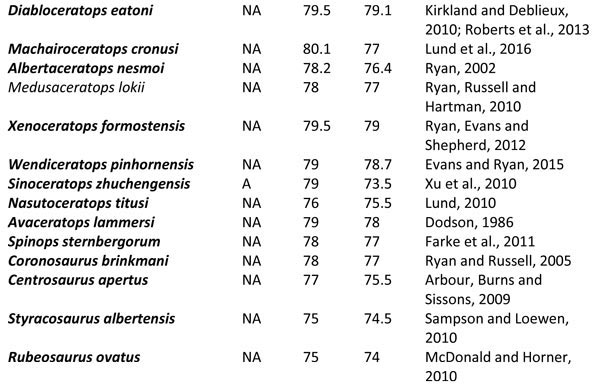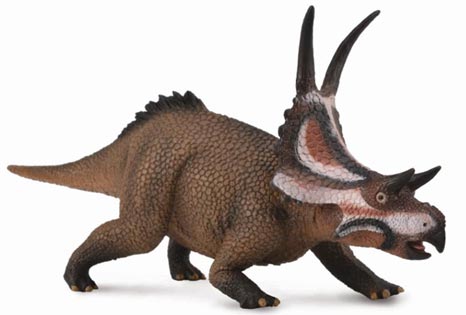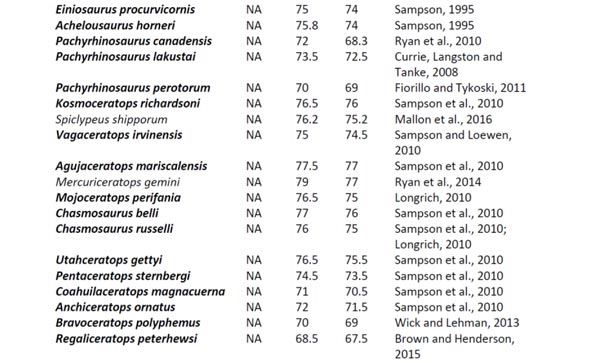Ceratopsian Species – When and Where they Lived (Part 2)
Ceratopsian Species – Where and When did they Live (part 2)
We conclude our look at the remarkable data that was used to compile a statistical analysis of the Ceratopsia. The research, published recently in the “Proceedings of the Royal Society B (Biology)”, examined the horned dinosaur family tree and set about building a picture of where and when horned dinosaur species lived. Using this data, which involved more than seventy species, the scientists were able to conclude that horned dinosaur ornamentation probably evolved, not as a method of telling different species apart, but as a way of demonstrating an individual’s fitness for breeding.
Cataloguing Ceratopsian Species
Ostentatious and elaborate crests, horns and frills may have had numerous roles, defence being one, for example, but they would also (most likely), have had a “social-sexual” function.
As a spokesperson from Everything Dinosaur stated:
“All those lumps and bumps, horns and frills were basically signalling to other members of the species – look how big and strong I am, I can carry around all this extra weight, so I must be a healthy horned dinosaur and therefore an ideal mate!”
To read our original article on the ceratopsian research: Why Did Horned Dinosaurs Have Fancy Frills?
The supplementary data associated with the scientific paper included some fantastic details of the ceratopsian family tree. In order to conduct their analysis, the research team compiled a table of horned dinosaurs and listed where they lived and approximately when (upper and lower margins of stratigraphical distribution). In an earlier article, we published the first part of this extensive table, today, we conclude our blog articles on this fascinating piece of ceratopsian research by posting up the rest of the data.
Plotting Ceratopsian Species Against Temporal and Geographical Distribution (Part 3)
Table credit: Andrew Knapp, Robert J. Knell, Andrew A. Farke, Mark A. Loewen, David W. E. Hone published in the Proceedings of the Royal Society B (Biology).
The table (above), shows part 3 of the temporal calibrations and geographical locations of ceratopsian species. Taxa that were included in the morphological character state analysis (the research into crests and horns), are indicated in bold type. Region abbreviations: Asia: A; North America: NA; Europe: E. The source of the table data is shown on the right.
This part of the ceratopsian table helps to demonstrate the diversity of the horned dinosaurs in North America during the Late Cretaceous, especially on the western part of the continent, the landmass known as Laramidia.
For models of horned dinosaurs and other prehistoric animals: Dinosaurs and Prehistoric Animal Models.
The Ornamentation of Diabloceratops (D. eatoni) was Included in the Study
Campanian and Maastrichtian Stages
Tables (3 and 4) list the horned dinosaur species from the later stages of the Cretaceous (Campanian and Maastrichtian). In part 4 (shown below), the dominance of ceratopsian species from North America continues with a further nineteen North American species listed.
Plotting Ceratopsian Species Against Temporal and Geographical Distribution (Part 4)
Table credit: Andrew Knapp, Robert J. Knell, Andrew A. Farke, Mark A. Loewen, David W. E. Hone published in the Proceedings of the Royal Society B (Biology).
The Very Last of the Horned Dinosaurs
The last parts of the data table focus on the youngest species of horned dinosaur known. These are the ceratopsians that lived during the last few million years of the Cretaceous. Once again, North America is the only continent represented in this part of the table. This does not mean that horned dinosaurs were extinct elsewhere in the world, that cannot be inferred from the information provided, but it is worth noting that no Asian horned dinosaurs for example, are known from the Maastrichtian faunal stage of the Late Cretaceous.
Plotting Horned Dinosaur Species Against Temporal and Geographical Distribution (Part 5)
Table credit: Andrew Knapp, Robert J. Knell, Andrew A. Farke, Mark A. Loewen, David W. E. Hone published in the Proceedings of the Royal Society B (Biology).
Ceratopsian Species – Last of All Triceratops prorsus
The last three species listed are all believed to be the youngest of the horned dinosaurs described so far, in terms of geological age. The two species of Triceratops are known from the Hell Creek Formation, whilst the controversial Nedoceratops (known from only one skull and therefore thought by some palaeontologists to be nomen dubium), comes from the Lance Formation of Wyoming. All three species are classified as members of the Ceratopsidae sub-family Chasmosaurinae, which with Torosaurus also a chasmosaur (T. latus listed in table 5), suggests that centrosaurine dinosaurs may not have persisted to the very end of the Age of Dinosaurs.
Plotting Horned Dinosaur Species Against Temporal and Geographical Distribution (Part 6)

Table credit: Andrew Knapp, Robert J. Knell, Andrew A. Farke, Mark A. Loewen, David W. E. Hone published in the Proceedings of the Royal Society B (Biology).
Triceratops – One of the Very Last of All the Dinosaurs
We once again congratulate the researchers for producing such an amazing study and for making available in the supplementary data all these really informative tables.
For the first part of our review of the ceratopsian data tables: Ceratopsian Species – When and Where They Lived (Part 1).
The Everything Dinosaur website: Everything Dinosaur.






